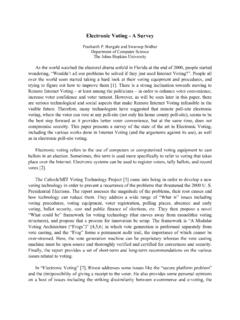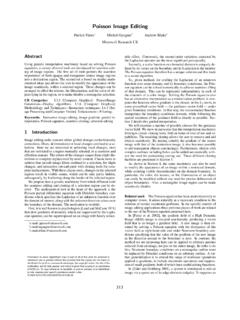Transcription of De Bruijn Graph assembly - Department of Computer Science
1 De Bruijn Graph assemblyBen LangmeadYou are free to use these slides. If you do, please sign the guestbook ( ), or email me and tell me brie!y how you re using them. For original Keynote "les, email assembly methodsBoth handle unresolvable repeats by essentially leaving them outFragments are contigs (short for contiguous)Unresolvable repeats break the assembly into fragmentsOLC: Overlap-Layout-Consensus assemblyDBG: De Bruijn Graph assemblya_long_long_long_timea_long_long _timea_long long_timeAssemble substrings with Greedy-SCSA ssemble substrings with OLC or DBGDe Bruijn Graph assemblyA formulation conceptually similar to overlapping/SCS, but has some potentially helpful properties not shared by k-mer is a substring of length kGGCGATTCATCGATTCA 4-mer of S:S:All 3-mers of S.
2 GGC GCG CGA GAT ATT TTC TCA CAT ATC TCGI ll use k-1-mer to refer to a substring of length k - 1mer: from Greek meaning part De Bruijn graphAAA, AAB, ABB, BBB, BBAAs usual, we start with a collection of reads, which are substrings of the reference is a k-mer (k = 3). AA is its left k-1-mer, and AB is its right ABLR3-merAAB s left 2-merAAB s right 2-merDe Bruijn graphAAA, AAB, ABB, BBB, BBATake each length-3 input string and split it into two overlapping substrings of length 2.
3 Call these the left and right , AA, AA, AB, AB, BB, BB, BB, BB, BALet 2-mers be nodes in a new Graph . Draw a directed edge from each left 2-mer to corresponding right 2-mer:AAABBABBLRLRLRLRLREach edge in this Graph corresponds to a length-3 input stringAAABBBA take all 3-mers:form L/R 2-mers:De Bruijn graphAAABBABBAn edge corresponds to an overlap (of length k-2) between two k-1 mers. More precisely, it corresponds to a k-mer from the Bruijn graphAAABBABBIf we add one more B to our input string: AAABBBBA, and rebuild the De Bruijn Graph accordingly, we get a multigraphDirected multigraph G(V, E) consists of set of vertices, V and multiset of directed edges, EOtherwise, like a directed graphabcdV = { a, b, c, d }E = { (a, b), (a, b), (a, b), (a, c), (c, b) }RepeatedNode s indegree = # incoming edgesNode s outdegree = # outgoing edgesDe Bruijn Graph is a directed multigraphEulerian walk de!
4 Nitions and statementsNode is balanced if indegree equals outdegreeNode is semi-balanced if indegree differs from outdegree by 1A directed, connected Graph is Eulerian if and only if it has at most 2 semi-balanced nodes and all other nodes are balancedGraph is connected if each node can be reached by some other nodeJones and Pevzner section walk visits each edge exactly onceNot all graphs have Eulerian walks. Graphs that do are Eulerian. (For simplicity, we won t distinguish Eulerian from semi-Eulerian.)De Bruijn graphAAA, AAB, ABB, BBB, BBABack to our De Bruijn graphAA, AA, AA, AB, AB, BB, BB, BB, BB, BAAAABBABBLRLRLRLRLRIs it Eulerian?
5 Argument 1: AA AA AB BB BB BAArgument 2: AA and BA are semi-balanced, AB and BB are balancedYesDe Bruijn graphA procedure for making a De Bruijn Graph for a genome Start with an input string:a_long_long_long_timeTake each k mer and split into left and right k-1 mers Pick a substring length k:5long_long ong_Add k-1 mers as nodes to De Bruijn Graph (if not already there), add edge from left k-1 mer to right k-1 merAssume perfect sequencing where each length-k substring is sequenced exactly once with no errorsng_lg_loa_lo_lonlongong_ng_tg_ti_t imtimea_lo_lona_lo_lonlonga_lo_lonlongon g_ong_ng_la_lo_lonlongng_lg_loong_a_lo_l onlongng_lg_loa_lo_lonlongong_ng_lg_loa_ lo_lonlongong_ng_lg_loa_lo_lonlongong_Fi rst 8 k-mer additions.
6 K = 5a_long_long_long_timeDe Bruijn graphng_lg_loa_lo_lonlongong_ng_tng_lg_l oa_lo_lonlongong_ng_tg_ting_lg_loa_lo_lo nlongong_ng_tg_ti_timng_lg_loa_lo_lonlon gong_ng_tg_ti_timtimeng_lg_loa_lo_lonlon gong_Finished grapha_long_long_long_timeLast 5 k-mer additions, k = 5De Bruijn graphWith perfect sequencing, this procedure always yields an Eulerian Graph . Why?ng_lg_loa_lo_lonlongong_ng_tg_ti_tim timeNode for k-1-mer from left end is semi-balanced with one more outgoing edge than incoming *Node for k-1-mer at right end is semi-balanced with one more incoming than outgoing ** Unless genome is circularOther nodes are balanced since # times k-1-mer occurs as a left k-1-mer = # times it occurs as a right k-1-mer De Bruijn graphDe Bruijn Graph implementationclass DeBruijnGraph: """ A De Bruijn multigraph built from a collection of strings.
7 User supplies strings and k- mer length k. Nodes of the De Bruijn Graph are k- 1- mers and edges join a left k- 1- mer to a right k- 1- mer. """ @staticmethod def chop(st, k): """ Chop a string up into k mers of given length """ for i in xrange(0, len(st)- (k- 1)): yield st[i:i+k] class Node: """ Node in a De Bruijn Graph , representing a k- 1 mer """ def __init__(self, km1mer).
8 = km1mer def __hash__(self): return hash( ) def __init__(self, strIter, k): """ Build De Bruijn multigraph given strings and k- mer length k """ = {} # multimap from nodes to neighbors = {} # maps k- 1- mers to Node objects = k for st in strIter: for kmer in (st, k): km1L, km1R = kmer[:- 1], kmer[1.]
9 ] nodeL, nodeR = None, None if km1L in : nodeL = [km1L] else: nodeL = [km1L] = (km1L) if km1R in : nodeR = [km1R] else: nodeR = [km1R] = (km1R) (nodeL, []).
10 Append(nodeR)Chop string into k-mersFor each k-mer, "nd left and right k-1-mersCreate corresponding nodes (if necessary) and add edgeFor Eulerian Graph , Eulerian walk can be found in O(| E |) time. | E | is # Graph into one with Eulerian cycle (add an edge to make all nodes balanced), then use this recursive procedure# Make all nodes balanced, if not alreadytour = []# Pick arbitrary nodesrc = ().next() def __visit(n):while len(g[n]) > 0:dst = g[n].pop()__visit(dst) (n) __visit(src)# Reverse order, omit repeated nodetour = tour[::- 1][:- 1]# Turn tour into walk, if necessaryInsight: If C is a cycle in an Eulerian Graph , then after removing edges of C, remaining connected components are also Bruijn graphFull illustrative De Bruijn Graph and Eulerian walk.














